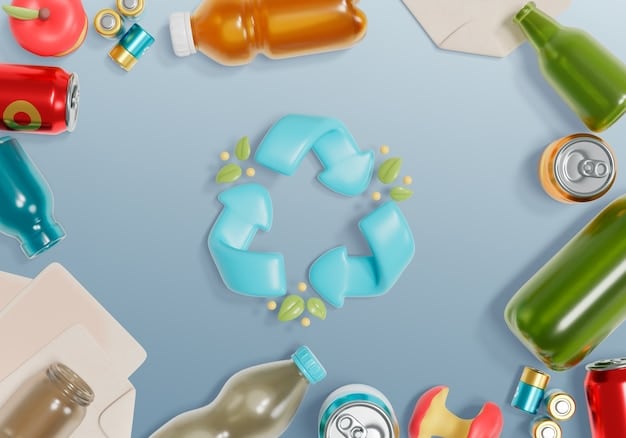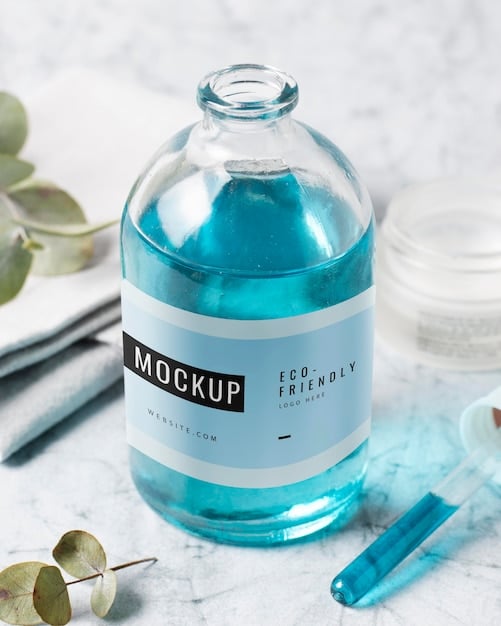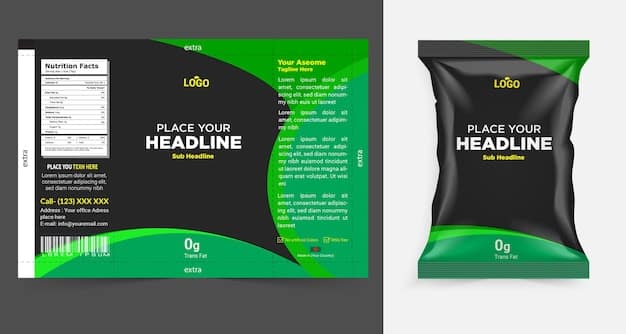US Consumers: Spotting & Avoiding Greenwashing in 2025

US Consumers: How to Identify and Avoid Greenwashing Tactics Used by Companies in 2025? This article explores how companies mislead consumers with false environmental claims and provides strategies for recognizing and avoiding these tactics.
Are you a US consumer trying to make eco-friendly choices? It’s becoming increasingly challenging to differentiate genuine sustainability from deceptive marketing. This guide will help you, as one of many US Consumers: How to Identify and Avoid Greenwashing Tactics Used by Companies in 2025.
In this article, we’ll uncover the common greenwashing strategies and empower you to make informed purchasing decisions that align with your values. Let’s dive in and equip you with the tools to stay ahead of the greenwashing curve!
Understanding Greenwashing: What It Is and Why It Matters
Greenwashing is the deceptive practice of promoting products or services as environmentally friendly when they are not. This can mislead consumers who are trying to make sustainable choices, and it erodes trust in genuine eco-friendly initiatives.
In 2025, as sustainability becomes even more critical, understanding greenwashing is crucial. It’s not just about marketing; it’s about accountability and transparency. Recognizing the signs of greenwashing empowers consumers to make informed decisions.
Common Greenwashing Tactics
Companies employ various tactics to create a false impression of environmental responsibility. Being aware of these strategies is the first step in protecting yourself and supporting truly sustainable brands. These tactics include:
- Hidden Trade-Offs: Highlighting a single eco-friendly attribute while ignoring other environmental impacts (e.g., a product made with recycled content but with a high carbon footprint).
- Vagueness: Using poorly defined or broad terms like “eco-friendly” or “natural” without providing specific details.
- False Labels: Creating fake certifications or labels to mislead consumers into thinking a product meets certain environmental standards.
- Irrelevance: Emphasizing environmental aspects that are already legally required (e.g., CFC-free, when CFCs are already banned).

By learning to spot these tactics, you become a more discerning consumer, capable of supporting truly sustainable businesses and avoiding those that prioritize profit over environmental responsibility.
Ultimately, understanding and identifying greenwashing is about promoting authenticity and integrity in the marketplace. It’s about encouraging companies to commit to meaningful sustainability efforts rather than relying on misleading marketing tactics.
How to Identify Greenwashing: A Checklist for US Consumers in 2025
Identifying greenwashing requires a critical eye and a willingness to dig deeper than surface-level marketing. US consumers need to be particularly vigilant, recognizing that companies may tailor their messaging to appeal to specific regional values.
To effectively US Consumers: How to Identify and Avoid Greenwashing Tactics Used by Companies in 2025, consider the following checklist when evaluating a product or service.
Checklist for Spotting Greenwashing
Use this checklist to assess the legitimacy of a company’s environmental claims. It provides a structured approach to evaluating marketing messages and discerning genuine sustainability from deceptive practices:
- Look for Specifics: Do claims include quantifiable data or specific certifications, or are they vague and unsubstantiated?
- Verify Certifications: Are stated certifications legitimate and issued by reputable organizations?
- Assess the Entire Product Lifecycle: Does the company address the environmental impact of the product from sourcing to disposal?
- Consider the Source: Is the company transparent about its environmental practices, or are they difficult to find and verify?
This checklist empowers consumers to look beyond the marketing hype and evaluate the true environmental impact of products and services. It helps in identifying potential greenwashing tactics and making more informed purchasing decisions.
By utilizing this comprehensive checklist, US consumers can navigate the complexities of the market and confidently choose products that align with their values. Being vigilant ensures that your purchasing power supports genuine sustainability.
Decoding Environmental Claims: Beyond the Buzzwords
Environmental claims can often be confusing and misleading, especially when they rely on buzzwords like “eco-friendly,” “sustainable,” or “green.” These terms lack a standardized definition and can be used to exaggerate or misrepresent a company’s environmental impact.
To truly US Consumers: How to Identify and Avoid Greenwashing Tactics Used by Companies in 2025, it’s essential to understand the nuances of these claims and to look beyond the surface to the underlying data.]
Understanding Environmental Terminology
Familiarize yourself with common environmental terms and what they actually mean. This knowledge will help you interpret marketing messages more accurately and identify potential greenwashing tactics. Consider the following:
- Reusable: The product can be used more than once for its original purpose.
- Recyclable: The product can be collected, processed, and reused to create new products.
- Biodegradable: The product will break down naturally into simpler substances over time.
- Compostable: The product will break down in a compost environment, leaving no toxic residue.

By understanding these definitions, you can critically assess whether a product truly lives up to its environmental claims. Don’t rely solely on the label; seek additional information to confirm the product’s sustainability.
Ultimately, decoding environmental claims is about fostering a culture of accountability. It requires companies to back up their marketing messages with verifiable data and transparent practices, rather than relying on empty rhetoric.
Regulation and Certification: Navigating the Landscape
Government regulations and independent certifications play a crucial role in ensuring the accuracy and reliability of environmental claims. These measures help to protect consumers from greenwashing and promote fair competition in the marketplace.
For US Consumers: How to Identify and Avoid Greenwashing Tactics Used by Companies in 2025, it’s important to understand the regulatory and certification landscape.
Recognizing Reliable Certifications
Look for products that have been certified by reputable third-party organizations. These certifications provide an assurance that a product has met certain environmental standards. Examples of reliable certifications include:
- Energy Star: Indicates that a product meets strict energy efficiency guidelines set by the EPA.
- Fair Trade Certified: Ensures that products are produced in compliance with fair labor standards and sustainable farming practices.
- USDA Organic: Verifies that agricultural products are grown according to organic farming standards.
- Rainforest Alliance Certified: Promotes sustainable agriculture practices that protect biodiversity and worker rights.
Be aware that not all certifications are created equal. Research the certifying organization to ensure that it is independent, credible, and has rigorous standards.
In conclusion, regulations and certifications are vital tools in the fight against greenwashing. By supporting certified products, you can have greater confidence that you are making environmentally responsible choices.
Empowering Yourself: Resources and Tools for US Consumers in 2025
Staying informed about greenwashing and making sustainable choices requires continuous effort. Fortunately, many resources and tools are available to help US consumers navigate the complexities of the market.
US Consumers: How to Identify and Avoid Greenwashing Tactics Used by Companies in 2025 can leverage these platforms to enhance their knowledge and make informed decisions.
Useful Resources and Tools
Take advantage of the following resources and tools to stay informed and make sustainable choices:
- Consumer Reports: Provides independent product reviews and ratings, including environmental assessments.
- GoodGuide: Offers ratings and information on the social and environmental performance of products.
- EWG’s Skin Deep Database: Rates the safety and environmental impact of cosmetics and personal care products.
- Green Seal: Provides certifications for products that meet rigorous environmental standards.
By utilizing these resources, you empower yourself to make informed purchasing decisions and support businesses that are genuinely committed to sustainability. It’s about taking control and shaping a marketplace that values environmental responsibility.
Ultimately, being an empowered consumer is about making informed decisions that align with your values. It requires a commitment to continuous learning, critical thinking, and holding companies accountable for their environmental claims.
| Key Point | Brief Description |
|---|---|
| 🔎 Spotting Greenwashing | Look for vague terms and hidden trade-offs in marketing claims. |
| ✅ Verify Certifications | Ensure environmental certifications are from reputable organizations. |
| 🌱 Understanding Terminology | Learn what terms like “recyclable” and “biodegradable” truly mean. |
| 📚 Use Resources | Consult resources like Consumer Reports for product assessments. |
Frequently Asked Questions (FAQ)
Greenwashing is when companies deceptively market their products as environmentally friendly. It’s important because it misleads consumers, preventing them from making genuinely sustainable choices and supporting truly eco-conscious businesses.
Look for specific, quantifiable data and third-party certifications from reputable organizations. Be wary of vague terms like “eco-friendly” without supporting evidence. Research the company’s overall environmental practices for transparency.
The Federal Trade Commission (FTC) provides guidelines on environmental marketing claims, but enforcement can be limited. Consumers can play a role by reporting misleading claims and supporting companies with transparent practices.
Be cautious of terms like “natural,” “eco-friendly,” and “sustainable” without specific details or certifications to back them up. These terms are often loosely defined and can be used to mislead consumers.
Consult resources like Consumer Reports, GoodGuide, and the EWG’s Skin Deep Database for independent assessments. Look for products with certifications from reputable organizations like Energy Star and the Rainforest Alliance.
Conclusion
In conclusion, US Consumers: How to Identify and Avoid Greenwashing Tactics Used by Companies in 2025 requires vigilance, education, and a commitment to informed purchasing. By understanding common greenwashing tactics, decoding environmental claims, and leveraging available resources, you can support truly sustainable businesses.
Empower yourself with the knowledge and tools to make conscious choices that align with your values, fostering a marketplace accountable for environmental responsibility. Your decisions drive change!





